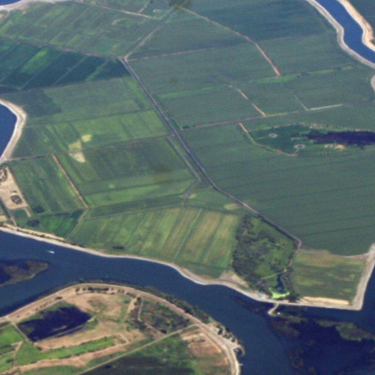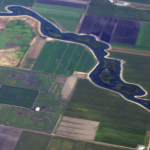This past week a number of federal, state, and local agencies took a significant first step toward negotiation of Voluntary Agreements (VAs) that could be the basis for implementing updated water quality objectives for California’s Bay-Delta. This is a notable milestone but much work remains. The participating agencies must agree upon the details of the VAs, and ultimately, the State Water Resources Control Board must consider whether to adopt the VAs as the means to implement the Bay-Delta Water Quality Control Plan.
The memorandum of understanding (MOU) signed by the VA parties, and the term sheet attached to the MOU, explain the intent of those parties to present VAs to the State Board as an alternative to an adjudicatory water-rights proceeding to achieve water-quality objectives. The components of the VAs include water contributed by agencies who hold water rights in the Bay-Delta watershed, commitments to habitat restoration for native fish, and financial contributions from federal, state, and local agencies to fund that habitat restoration, to purchase additional water, and to fund scientific activities and adaptive resource management.
The work ahead should be informed by scientific information but, more importantly, by societal values as Sheila Jasanoff explains in Technologies of humility. She observes, “Researchers and policy-makers need ways for accommodating the partiality of scientific knowledge and for acting under the inevitable uncertainty it holds.”
Science cannot be expected to be the panacea for a century and a half of deleterious changes to the Bay-Delta ecosystems. Science alone cannot set us on the “right” resource management pathway to allocating finite water resources in an era of climate change. But it can both inform policy decisions intended to reflect our values and contribute to the implementation of those decisions in a manner that allows us to discern if those policy decisions as implemented actually reflect those values or have unintended consequences.
There are three ways in which scientific information can inform the continued development and assessment of the VAs in order to the maximize the likelihood of success both in getting the VAs adopted by the State Board and in implementing them in a manner that advances the values reflected in the narrative objectives described by the State Board and in the draft term sheet shared by the federal, state, and local agencies.
First, scientists can provide advice regarding the selection of metrics to ascertain whether the combination of actions intended to benefit native fish species and their habitats are successful. The VA parties contemplate an eight year effort to leverage agreed upon resources to contribute to achievement of the narrative objectives. The metrics will inform a State Board determination at year eight whether to continue, modify, or scrap the VAs. By and large, the metrics chosen will be proxies for the variables of interest.
For example, we cannot measure the “viability” of a target species or the “quality of habitat” available to such species. But there is a robust body of scientific literature that can inform our selection and validation of proxies (or surrogates). The process should begin with an explanation of why it is necessary to use a proxy rather than direct assessment of the variable of interest. The second step is to apply a structured, deductive process to match the proxy with the variable of interest. The third step is to describe the similarities and differences between the proxy and the variable of interest. And the final step is to describe how monitoring will be used to explore the hypothesized relationship between the proxy and variable of interest in order to facilitate learning and adaptive management. Variations on this theme are described by Seth Wenger in Use of surrogates to predict the stressor response of imperiled species and Chloe Sato et al. in The use and utility of surrogates in biodiversity monitoring programmes.
Second, scientists can assist with design of a monitoring plan in order to gather data on the metrics chosen by the VA parties and State Board, as well as baseline data on (i) the status and trend of populations of target species and (ii) the factors affecting the population dynamics and habitat quality for such species. In late 2021, the Delta Independent Science Board (ISB) released a draft report on monitoring in which it urges the broader community to reimagine monitoring in the Bay-Delta. While it is neither necessary nor appropriate to expect the VA parties to single-handedly take on this task. They should be mindful of the fact that the ISB’s recommendation reflects the persistent, historical failure of the federal and state agencies to design and implement monitoring efforts in a manner that provide us with sufficient information on both status and trend across species of interest and the data necessary to assess the efficacy of major management actions intended to benefit those species.
Fortunately, U.S. Fish and Wildlife and U.S. Geological Survey scientists have addressed monitoring for evaluating the effectiveness of management actions relative to program objectives in Monitoring in the context of structured decision-making and adaptive management and identifying environmental attributes and how they can be measured in A road map for designing and implementing a biological monitoring program.
Third, science can lead to formulation and implementation of more robust VAs through use of independent science review at appropriate junctures in the process. The Delta Stewardship Council has endeavored to develop science review capacity both via the Delta Science Plan, which sets forth guidance for effective use of science reviews, and through the standing Independent Science Board. The VAs include parties and actions upstream of the Delta, understanding that ecosystems cross political boundaries. Nonetheless, both the science capacity and the guidance on prevailing practices reflected in the Delta Science Plan as well as the standing scientific literature provide valuable guidance on the appropriate use of independent scientific review in the context of the VAs. Best practices in the use of independent scientific review agency documents and determinations include:
· ensuring expert reviewers deliberate as a panel,
· the appointment of panels with a sufficient range of skills and balance,
· use of a third-party neutral to administer reviews including development of the task statement and determination of the scope of the review,
· adequate time and resources to complete the review, and
· the requirement that the authoring agency respond to reviewer input.
Dennis Murphy and Paul Weiland describe those best practices in more detail in Independent scientific review under the Endangered Species Act.
Each of the endeavors above can be incorporated into a broader effort to formulate and implement the VAs in an adaptive management framework. The VA parties have committed to utilize adaptive management. They can look to federal agency guidance on adaptive management in Adaptive Management: the U.S. Department of the Interior Technical Guidance and a step-through template in A Systems Approach to Ecosystem Adaptive Management: A USACE Technical Guide. The latter reflects current best practices and offers a roadmap for implementation.
Unfortunately, the structured, step-wise process of adaptive management is seldom followed attentively. However, if it is embraced early in the process and if the VA parties are able to employ metrics, monitoring, and independent science review, they may be able to develop and implement actions in a manner that enhances the likelihood of success, reduces uncertainty, and facilitates course changes where appropriate.







No Comments